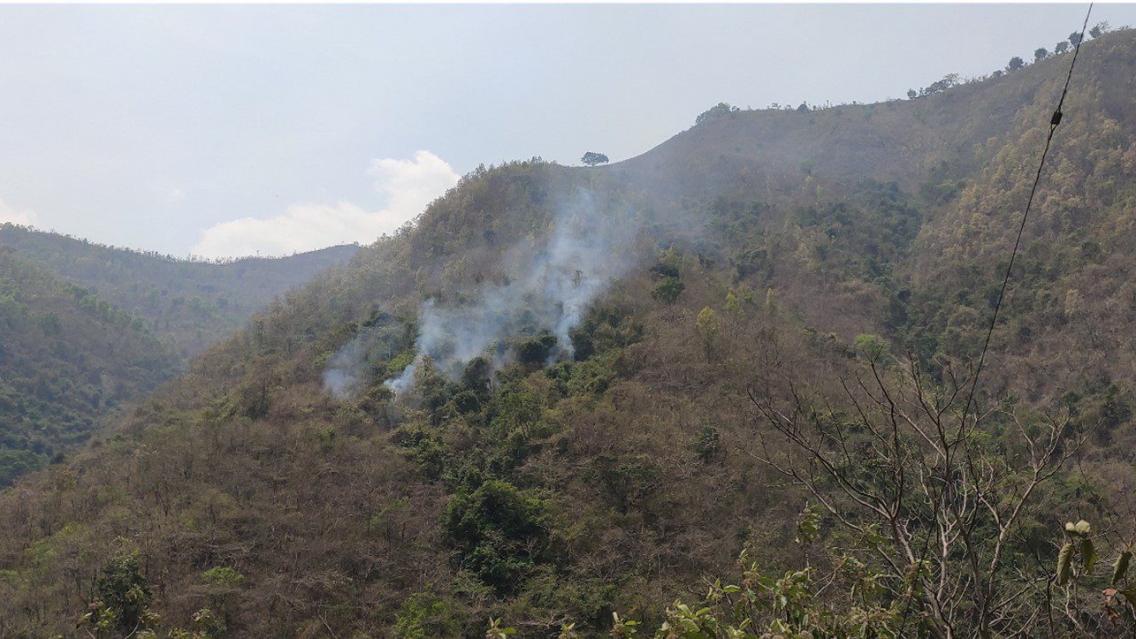Fortifying Forest Fire Forecasting for Nepal

Between January 1st and June 16, 2023, Nepal experienced 118% more forest fires than it had in all of 2022. The country’s Department of Forests and Soil Conservation (DoFSC) has reported 2,294 forest fires as of June 16th this year. The spike is attributed to a dry winter and minimal rainfall.
Fires play an important role in forest ecosystems, helping vegetation growth and strengthening a forest’s resilience to disease, but with climate change forest fires can go from a low-intensity, low-severity event to a catastrophically destructive, stand-replacing blaze. Such severe wildfires are a significant threat to ecosystems, wildlife, and human communities worldwide, significantly lowering air quality and adversely affecting public health. Forests also play a critical role in storing carbon, thereby helping to mitigate climate change.
In Nepal, forest fire “season” typically starts in December, peaks in April, and recedes with the monsoon in June. This year, the surge in forest fires led to worsened air quality which impacted human and animal health and reduced visibility, with numerous flight cancellations and delays in major airports.
To help authorities better monitor and manage forest fires, SERVIR’s partner in the mountainous Hindu Kush and Himalaya (HKH) region, the International Centre for Integrated Mountain Development (ICIMOD), developed a two-day fire outlook that provides a general index of fire risk throughout Nepal’s forests. This is the first early warning system for forest fires in Nepal. The outlook enables government forest fire managers to anticipate and prepare for fires, making informed decisions about deploying resources, implementing fire prevention measures, and carrying out controlled burns to reduce risk.
This fire outlook provides a reliable and accurate nationwide assessment of potential fire dangers. The outlook uses temperature, relative humidity, wind speed, and precipitation data from the High-Impact Weather Assessment Toolkit (HIWAT) – Nepal along with a customized fire weather index.
“The fire outlook will enhance forest fire management efforts in Nepal. It will provide early warning on potential fire incidents across the country and allow forest management officials to take precaution and swift action,” observed Rabindra Maharjan, Deputy Director General at the DoFSC.
“This is the first early warning system for forest fires in Nepal. It is a significant enhancement in our efforts to provide innovative and effective remote sensing and geospatial solutions to address forest fires in Nepal,” said Birendra Bajracharya, Chief of Party – SERVIR HKH, ICIMOD.
The fire outlook has been incorporated in Nepal’s Forest Fire Detection and Monitoring System, an operational system that provides information on historical forest fires and near real-time fire detection and monitoring. SERVIR HKH developed the system in close collaboration with Nepal’s DoFSC Ministry of Forests and Environment in 2012.
Nepal’s Forest Fire Detection and Monitoring System assimilates active fire data three times a day from NASA’s website, adding important information such as land cover, elevation, slope, and the locations of protected areas.
In a story about the benefits of the satellite-based forest fire detection and monitoring system, Indra Sapkota, District Forest Officer at Solukhumbu noted, “By quantifying forest fire incidences and identifying vulnerable zones using this system, we were able to budget for activities towards community mobilization and forest fire management in the new fiscal year. We requested resources from the Department of Forests and channeled them into programs geared towards averting forest fires.”
The DoFSC has been using the system to closely monitor, report, and respond to forest fires nationwide. A dedicated unit within the department consolidates actions on the ground and manages the system in-house to capture information on reported fires, estimated damage, and fatalities.
“The fire outlook and the Forest Fire Detection and Monitoring System are excellent examples of how technology and collaboration can be leveraged to tackle environmental challenges. We are proud to partner with ICIMOD and the DoFSC in developing these tools to protect Nepal’s forests,” said Daniel Irwin, Global Program Manager for the SERVIR Program at NASA.
USAID Senior Climate Adaptation Advisor Pete Epanchin noted, “The fire outlook and detection tools are an excellent addition to Nepal’s carbon management resources. They pair well with SERVIR HKH’s previous work to create a land cover monitoring system for Nepal.”
SERVIR HKH at ICIMOD is working on scaling the approach to generate forest fire outlooks for additional countries in the region.
To learn more about the Forest Fire Detection and Monitoring System in Nepal and the fire outlook module, visit https://servir.icimod.org/science-applications/forest-fire-detection-and-monitoring-in-nepal/

